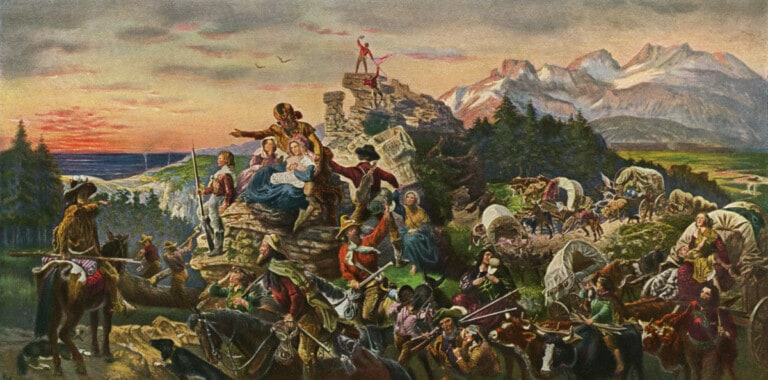A westward expansion
Expansion is both commercial and territorial. American expansion was always a sort of global attitude involving territorial growth and commercial expansion, exactly like a body that grows. America has always been perceived as a body.
The growth is so huge that nobody can do anything about it: unlimited development, though only extending to the West.
In 1800, the Western Boundary/Border was the Mississippi River. Beyond it, stood great areas of land, not very well known: 600 miles to the Rocky Mountains.
Louisiana was still a French territory (and France was then ruled by Napoleon). Napoleon sold Louisiana to the Americans for 15 million dollars to make war in Europe with Britain. As Louisiana was a huge territory, the American territories doubled over the night. Thanks, Napoleon!
Jefferson had sent explorers to the West to find an easy way to the Pacific. Louis and Clark left in 1804 and set off up the Missouri River. They marched for 10 weeks in the Rocky Mountains and ate their horses.
They finally reached the Columbia River, on which they floated down to the Pacific.
In December 1805, they reached the Pacific, after 4,000 miles. They failed to find an easy way but they showed the journey was possible and indirectly favoured expansion thanks to the useful information they brought back.
Oregon was a territory stretching from Alaska to California and to the Rocky Mountains to Louisiana.
In 1804, it was claimed by 4 countries: the US, Britain, Spain (owning California) and Russia (owning Alaska). The US and Britain had the strongest positions because they had sent people to scout to recognize the land and to settle trading posts.
Among those people, there were trappers (called “mountain men”) who spent their lives wandering for furs. In the 1830s, Britain had more settlements than the Americans:
- FEAR!
- American politicians made great efforts to persuade Americans to start farms in Oregon.
The journey was terrible, expensive and lasted for months. In 1832, settlers began travelling by land. The route was called the “Oregon Trail”, the first overland route to the Pacific and the American expansion.
It was not an easy journey because of the many dangers: floods, blizzards, prairie fires, accidents, diseases and starvation took many lives. But settlers continued.
In 1843, the Oregon Fever came to many parts of the US and contaminated thousands of people who set off in the West with wagons.
Gradually, they grew and outnumbered the British. It is typical of the process the Americans are going to use to claim that the territories are potentially theirs:
- settling down
- outnumbering the opponents
- indexing territories
Manifest destiny
“Manifest Destiny” was an expression coined by O’Sullivan in 1845. It will become the motto of the American expansion. The idea existed before the phrase was coined: it expressed the fundamental belief in America that the destiny of America was special because of the overruling Providence.
The fate of America is planned by God: it consists of expanding naturally. The first stage of this ideology is religious, and Calvinistic (chosenness and election). Then it is a secular ideal: instead of being divine, it becomes manifest so that everybody can see it.
Manifest Destiny became the natural ideology of the expansionists, demanding that the US should take the whole of Oregon to Alaska (54° 40″). Another motto was “54-40 or fight!”.
In 1844, James K. Polk was elected President on a Manifest Destiny platform. In his inaugural address, he said that “the American claim of the whole of Oregon is clear and unquestionable”.
At war with Mexico and Britain
As a result, a double war with Mexico and Britain broke out. In June, Polk agreed to divide Oregon into 2 parts on the 49th parallel of latitude. In 1846, the Americans were at war with Mexico.
That was the first real colonial war and it grew out of events having taken place in Texas. Thousands of Americans had settled in Texas, which was ruled by Mexico since the 1830s.
Texan Americans gradually opposed the Mexican rules and rebelled in October 1835. The Texans won against the Mexicans in 1836 at the Battle of San Jacinto. Texas became an independent republic.
Most Texans did not want their independence to last too long: they wanted to join the American territories. In 1845, Texas was part of the US.
In April 1846, there were some fights between American and Mexican soldiers along the Southern border between Texas and Mexico. American soldiers invaded Mexico defeated the Mexican army and occupied Mexico City in September 1847.
That Tex-Mex war ended in February 1848. Mexico lost big stretches of territory: California, New Mexico, Colorado, Nevada, Utah, and Arizona.
This indexation completed the Manifest Destiny of the USA and the process of continentalization. The result is the USA but the process is not yet completed.
Synopsis » From the Puritan settlements to the American Civil War (1787-1877)
- Antebellum South
- Introduction to Puritanism and Expansionism
- Life in the Plantations
- USA: North and South
- O’Sullivan’s Manifest Destiny
- The social context of America in the early 19th century
- The American Civil War: 1861-1865
- America: The New Nation
- After the American Civil War: The Reconstruction
- America: West to the Pacific
- Years of Growth

